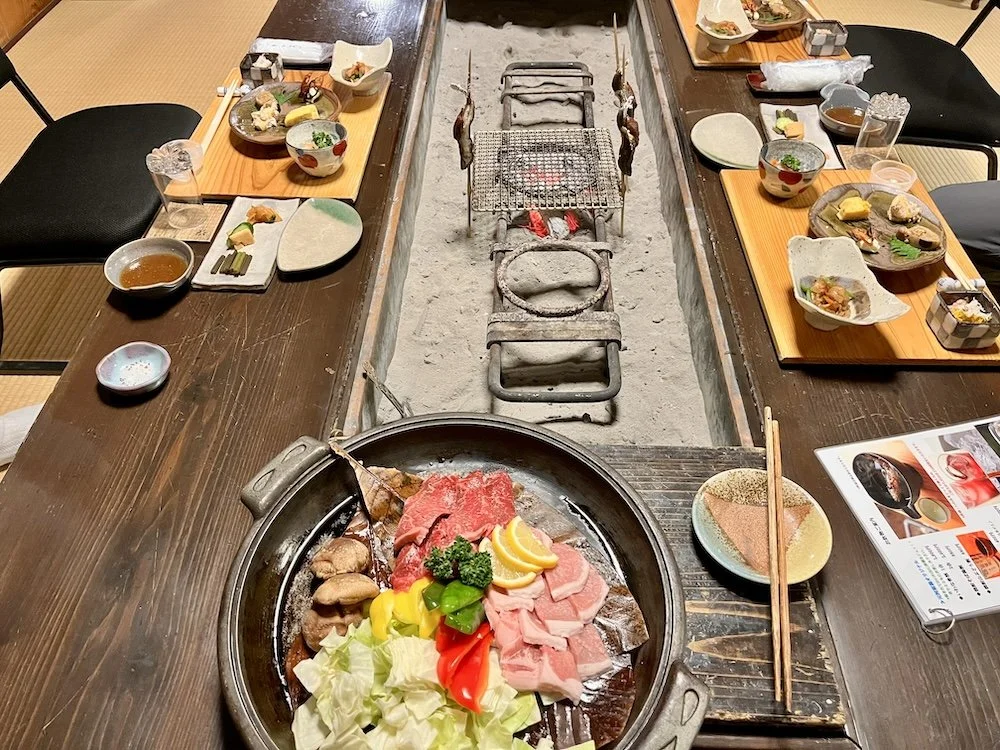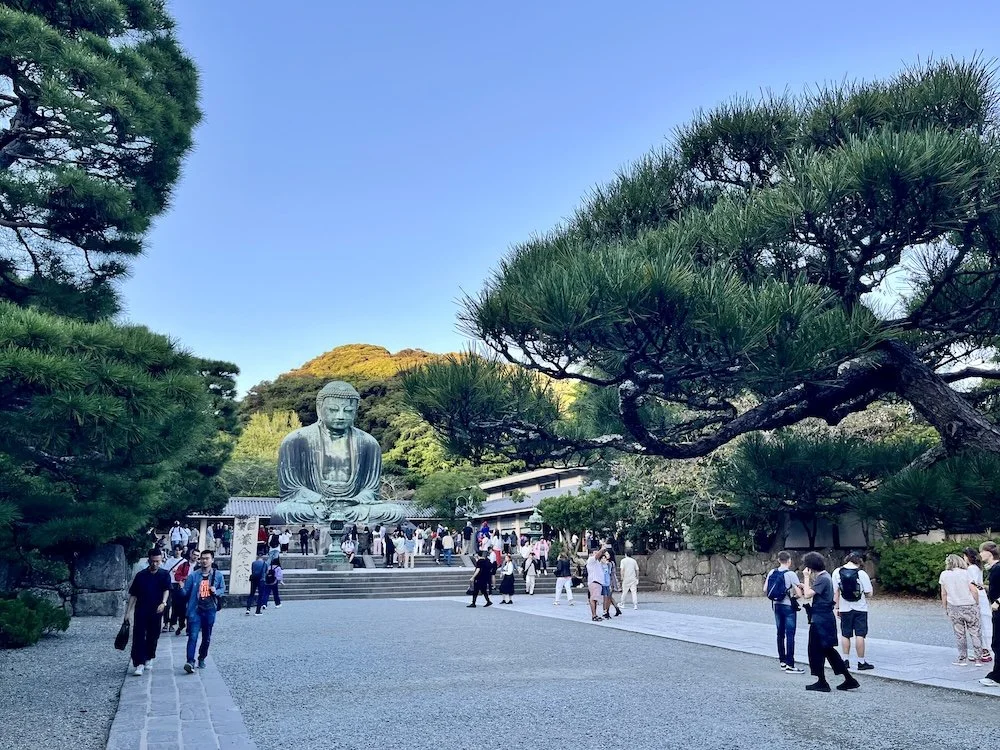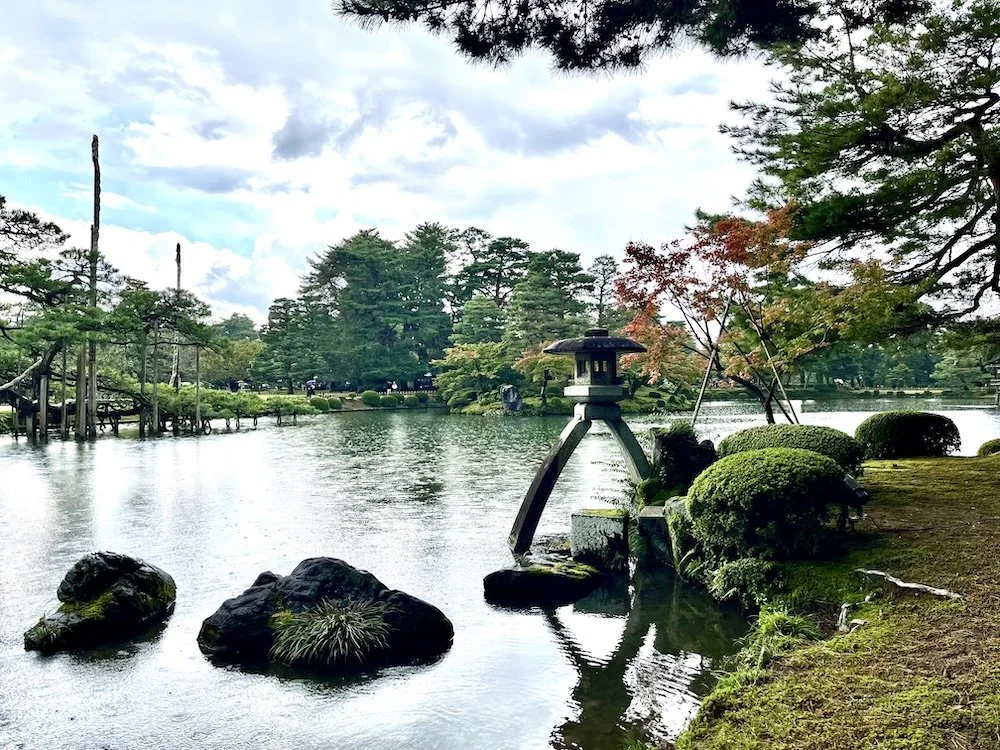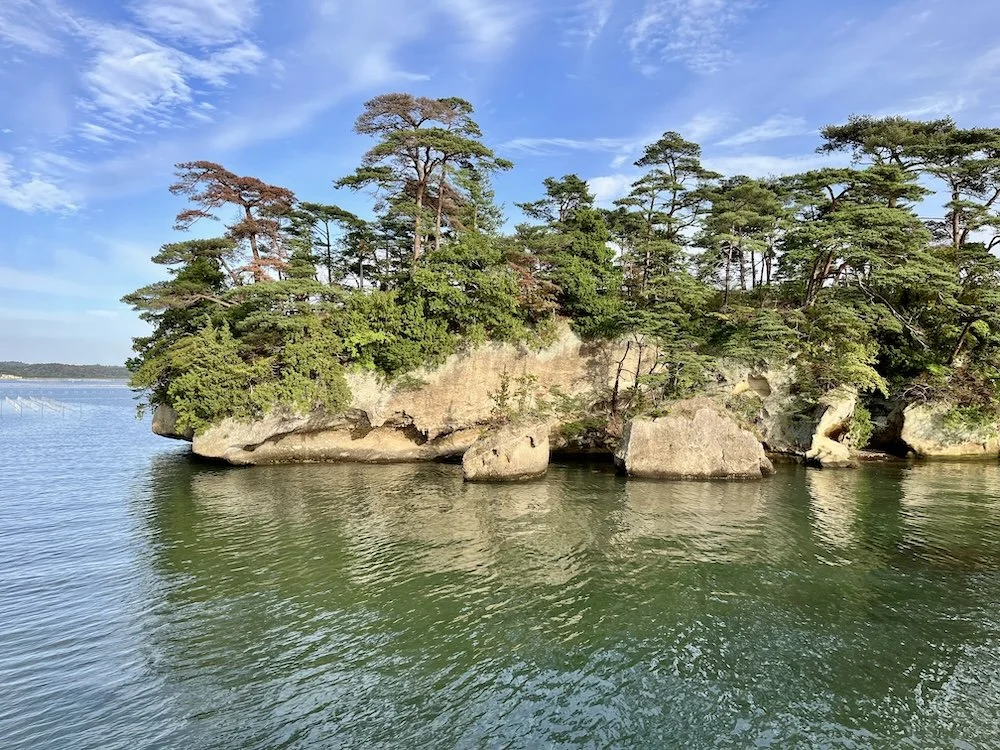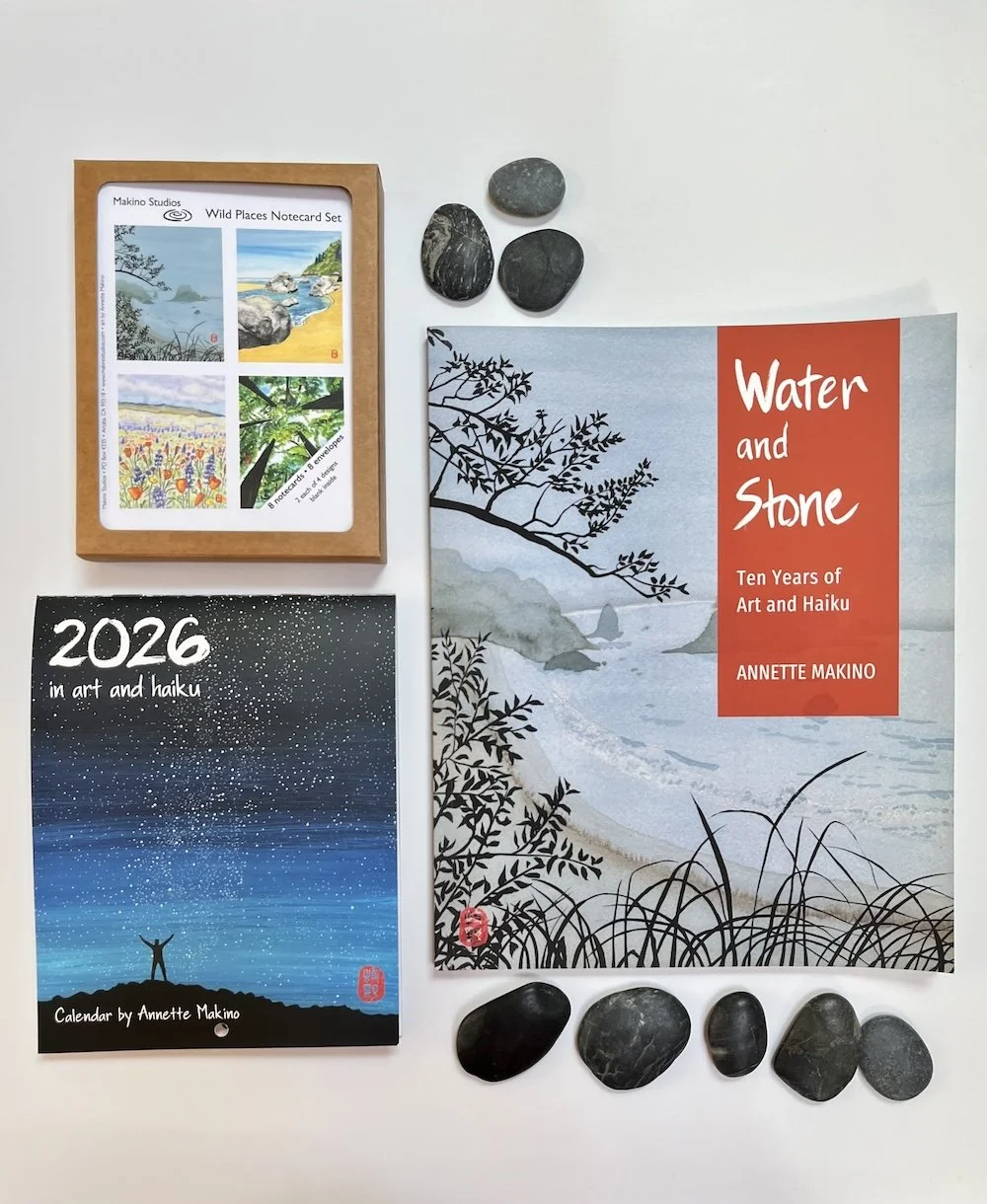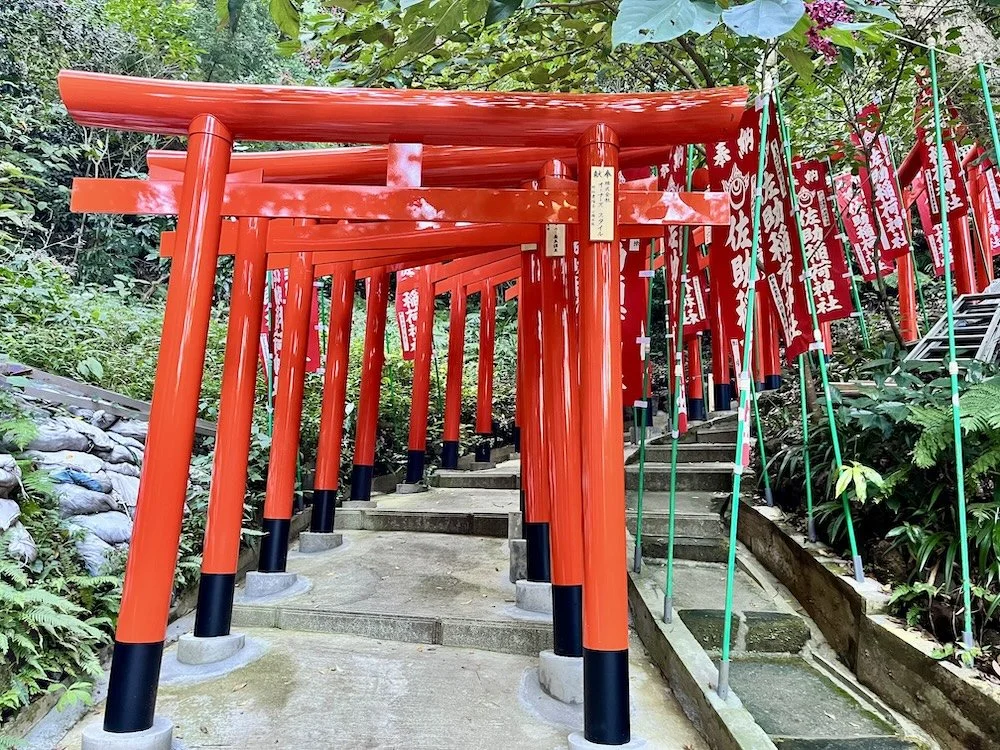The trail to Jizogura shrine (shown left) outside Hijiori Onsen village in the Tohoku region of Japan.
Paul, Annette and Gabriel in Tohoku, Japan, October 2025
Konnichiwa! I’m back from a wonderful 18 days in Japan with my husband Paul and son Gabriel. On this, my fifth trip there, we toured Tokyo boulevards, mountain trails, rice paddies, rural villages and temples.
sacred shrine
worshippers raise
their selfie sticks
Paul has been studying Japanese intensively and was able to have brief exchanges and read some signs, which was very helpful. The Google Maps and Google Translate apps were also key companions.
We traveled by subway, bus, bullet train, boat and on foot, walking up to ten miles a day even when we weren’t hiking.
rice paddies blurring into the past bullet train
Annette sitting at the feet of the master, 17th century haiku poet Matsuo Basho, at Motsuji Temple, Hiraizumi.
The focus of the trip was a six-day self-guided walking tour in the northern region of Tohoku following the route that haiku poet Matsuo Basho took over five months in 1689. That resulted in his classic haiku-laced travelogue, Oku-no-hosomichi, or Narrow Road to the Deep North. Basho is considered Japan’s greatest poet, and it was moving to visit places that he wrote about almost 350 years ago and to see the many statues and monuments commemorating him.
Paul warns bears of our presence on the trail.
Some trails had clappers and at one trailhead, our driver set off firecrackers to warn away bears before we started our hike. Being used to California’s shy black bears, we weren’t terribly worried, but after our walking tour we learned that since April of this year, bears have killed 12 people in Japan and injured more than one hundred! Luckily, we didn’t encounter any bears nor any evil wild monkeys.
At one of our inns, a dish was grilled at the table on magnolia leaves.
Our tour company, Walk Japan, reserved traditional Japanese inns for us which each had on-site onsen, or hot springs—a real treat after hiking for miles over mountain passes or trudging up a thousand temple stairs. These inns served amazing breakfasts and dinners of 12 to 18 courses each, exquisitely presented on various types of pottery or lacquerware. Most of it was delicious, if sometimes mysterious. But I drew the line at tasting the raw horse meat on one sashimi platter!
Amida Buddha in Kamakura, completed in 1252.
We spent a total of six days in Tokyo, where we got to see my Japanese relatives. There we also caught the women’s qualifying rounds for the Tokyo Open, especially fun for Gabriel, a tennis player and coach. We took a day trip to see the Great Buddha of Kamakura, which has appeared in Paul’s dreams, reaching the massive, serene sculpture via a hike past five temples.
The iconic two-legged stone lantern at Kenroku-en in Kanazawa.
For four nights we based ourselves in Nagano, in the Japan Alps. We made a day trip to Kanazawa to see one of the most famous gardens in Japan, peaceful Kenroku-en, and to explore the evocative old samurai neighborhood. Wandering through rainy alleys that evening, we stumbled into a restaurant where we were ushered into a private tatami room. There, servers in kimonos brought us gorgeous platters of sashimi and sushi followed by dessert decorated with gold leaf—our favorite meal of the trip.
A special dinner in a private tatami room in Kanazawa.
sushi bar
through fish tank glass
they watch us feeding
We also traveled to the charming town of Obuse one day to visit the Hokusai Museum, which showed the intricate step-by-step process for printing his famous woodblock print, “The Great Wave of Kanagawa.” I was humbled to learn that Hokusai created more than 30,000 artworks in his lifetime!
We took a boat ride around Matsushima Bay, which Basho found so beautiful that he couldn't write a single haiku about it.
I could go on and on, but I’ll let my photos do the talking. This trip was covered by Makino Studios, so a deep bow of gratitude to all who have supported my art business. And thanks for your patience with orders while I was traveling; I’m all caught up on shipments and store deliveries, so feel free to order now (free shipping through Sunday). And thanks for coming along on this trip to Japan! As Basho wrote, “every day is a journey, and the journey itself is home.”
warmly, Annette
•
Makino Studios News
Free shipping this weekend: I’m offering free shipping on everything in the shop, no minimum order, through midnight this Sunday with code JAPAN2025.
2026 calendars: These mini-calendars of art and haiku are now for sale in most of my local stores and available here for $12. They make great gifts!
New cards and notecards: You can browse all new and ongoing designs here. Some of the newest designs are already almost sold out, but more are coming in a couple of weeks.
Made in Humboldt Fair: The holiday market at Pierson Garden Shop in Eureka, CA starts this Monday, Nov. 12 and runs through Dec. 24. It includes more than 250 local vendors. You can find my calendars, notecard sets, books and prints there.
Arcata Holiday Craft Market: Featuring food, music, and local vendors, this festive fair takes place Dec. 13-14 at the Arcata Community Center in Arcata, CA. Look for the Makino Studios booth on the lefthand side of the main room. This will be my only in-person event this season.
•
Torii gates lead to Sasuke Inari Shrine in Kamakura.
Haiku credits:
“rice paddies” - Last Train Home: tanka, haiku, rengay; Ed. Jacqueline Pearce; Pondhawk Press; Vancouver, BC, Canada; 2021
“sacred shrine” - 3rd place, Gerald Brady Memorial Awards for Senryu, September 2016
“sushi bar” - Prune Juice, Issue 17, November 2015





